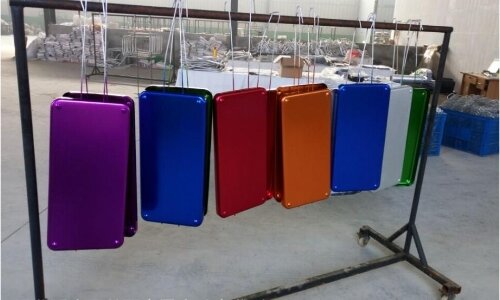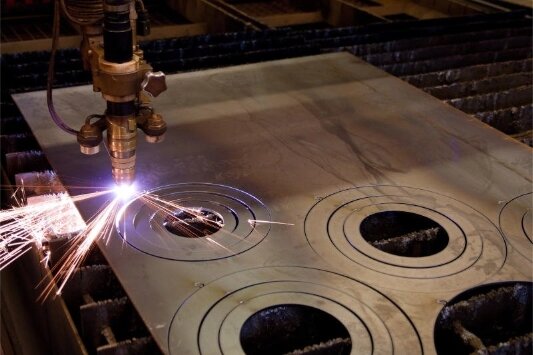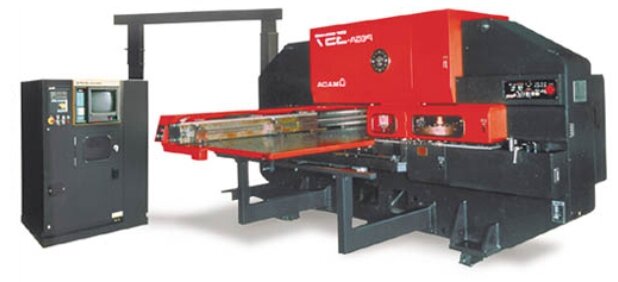Aluminum parts face different needs depending on their use. Some require a smooth, decorative surface, while others need high resistance to wear and corrosion. Anodizing helps meet both goals. It strengthens the surface, extends lifespan, and improves appearance.
Many engineers and designers often wonder which type to choose: Type II or Type III anodizing? Both protect aluminum, but they work in different ways. This article explains how they differ, what each offers, and how to choose the best option for your project.

Wat is anodiseren?
Anodiseren changes the surface of aluminum into a strong, protective oxide layer. This layer forms through an electrochemical process that thickens the natural oxide coating on the metal. It improves corrosion resistance, increases durability, and provides a better surface for coloring or sealing.
The process begins by placing aluminum parts in an acid bath, usually sulfuric acid. An electric current flows through the solution, with the aluminum serving as the anode. Oxygen from the electrolyte reacts with the aluminum surface to create a dense oxide layer. This layer bonds tightly to the metal and does not peel or flake off like paint or plating.
The thickness of this oxide layer depends on the process and performance needs. Thin layers focus on looks and corrosion protection. Thick layers boost hardness and wear resistance. The anodized surface can also hold dyes, giving long-lasting decorative colors.
Overview of Type II and Type III Anodizing
Both types of anodizing protect aluminum, but they are designed for different purposes. Type II and Type III coatings differ in their manufacturing process, appearance, and performance.
Type II (Conventional Sulfuric Acid Anodizing)
Type II anodizing, also known as standard or decorative anodizing, uses sulfuric acid to form a medium-thickness oxide layer. The coating typically ranges from 0.00007 to 0.001 inches (1.8-25 μm). It provides a smooth, clean surface that improves corrosion resistance and appearance.
The surface of Type II anodizing is porous, allowing it to absorb dyes effectively. Parts can be colored in shades like black, red, blue, or clear. After coloring, the surface is sealed to protect the color and prevent oxidation. This type of anodizing is commonly used in consumer electronics, panels, frames, and other parts that require both protection and a stylish finish.
Type II anodizing is best suited for indoor or mild outdoor use, where the parts are not subjected to heavy wear. It offers a cost-effective balance between good protection and a decorative look.
Type III (hardcoating anodiseren)
Type III anodizing, also known as hardcoat anodizing, produces a significantly thicker and denser oxide layer. The coating typically ranges from 0.0005 to 0.006 inches (13-150 μm). It is formed under higher voltage and lower temperature conditions, resulting in a more complex and compact structure.
The resulting surface is highly wear-resistant and can achieve hardness levels comparable to those of ceramics. Type III anodizing excels in harsh environments, protecting against abrasion, corrosion, and high temperatures. It is widely used in the aerospace, military, and heavy equipment industries, where long-term durability is crucial.
Type III coatings are harder and thicker but not as decorative. They often have a darker color and can slightly change part dimensions. Engineers should account for this in precise designs. Even so, Type III is the better choice for parts exposed to friction, impact, or extreme conditions.

Key Differences Between Type II and Type III Anodizing
Knowing the technical differences helps match each process to its best use. Below, we’ll break down how thickness, color, cost, and protection compare.
Coating Thickness and Hardness
Type II anodizing forms a thinner oxide layer, typically ranging from 1.8 to 25 μm in thickness. It provides good corrosion protection and a smooth finish, but it is not designed for heavy wear and tear. Type III anodizing creates a thicker layer, ranging from 13 to 150 μm in thickness. Its dense structure makes it much more complicated and more wear-resistant.
Type III coatings can achieve hardness levels of 60–70 Rockwell C, comparable to that of hardened steel. This makes them ideal for parts that face frequent movement, friction, or impact. Type II coatings focus more on looks and moderate protection rather than strength.
Color and Dye Compatibility
Type II anodizing readily absorbs dyes, resulting in bright and even colors. Its porous surface lets pigments sink in deeply before sealing. That’s why it’s popular for consumer and architectural parts that need a decorative finish.
Type III anodizing, however, does not take color well. Its dense layer limits dye absorption, so colors tend to be darker or duller. Most hard-coated anodized parts stay in natural gray or dark bronze shades. Even when dyed, the color is less uniform compared to Type II.
Temperature and Process Conditions
Both processes use sulfuric acid, but under different conditions. Type II runs at moderate voltage and temperatures between 68°F and 77°F (20°C–25°C). Type III operates at higher voltages and colder temperatures, typically below 40°F (4.4°C).
The colder environment slows the reaction, allowing a denser oxide layer to form. The higher voltage drives deeper oxidation into the surface, increasing hardness. These stricter conditions are why Type III coatings are stronger and more durable.
Cost and Production Time
Type III anodizing costs more and takes longer to produce. It requires higher voltage, lower temperatures, and longer processing times, which consume more energy and wear out equipment more quickly. The thicker coating also takes more time to build.
Type II anodizing is faster and more affordable. It’s the better choice for parts where appearance and corrosion protection are the main goals. Type III is used when parts must handle wear, friction, or harsh conditions that justify the extra cost.
Corrosie en slijtvastheid
Both types of anodizing protect aluminum from corrosion, but their strength under stress differs. Type II performs well in both indoor and light outdoor conditions. Type III offers significantly better protection in harsh environments, such as marine, industrial, or high-friction applications.
The thicker oxide layer of Type III acts like a rigid shield against salt, abrasion, and impact. It helps parts keep their shape and dimensions over time. Type II still resists corrosion well but wears faster when exposed to constant rubbing or movement.
| Functie | Type II Anodizing | Type III Anodizing (Hardcoat) |
|---|---|---|
| Protective Layer Thickness | 0.00007–0.001 in. (1.8–25 μm) | 0.0005–0.006 in. (13–150 μm) |
| Hardheid | Moderate; good for light wear | Very high; 60–70 Rockwell C (similar to hardened steel) |
| Oppervlakteverschijning | Smooth, bright, decorative | Dull to dark gray or bronze; less decorative |
| Color/Dye Capability | Excellent dye absorption; vibrant colors | Limited dye absorption; darker, muted tones |
| Corrosiebestendigheid | Good for indoor or mild outdoor use | Excellent for marine, industrial, or harsh environments |
| Slijtvastheid | Moderate; not for high-friction applications | Superior; resists abrasion, impact, and friction |
| Process Conditions | Moderate voltage; 68–77°F (20–25°C) | High voltage; below 40°F (4.4°C) |
| Cost and Production Time | Lower cost and faster production | Higher cost and longer processing time |
| Dimensional Change | Minimal impact on size | Slight dimensional growth due to thicker oxide |
| Typische toepassingen | Consumer electronics, panels, frames, indoor fixtures | Aerospace, defense, hydraulic parts, tools, heavy machinery |
Typical Applications in Sheet Metal Parts
Type II and Type III anodizing each serve different purposes in sheet metal fabrication. The right choice depends on how the part will be used, its appearance, and the level of wear it needs to resist.
When to Use Type II?
Type II anodizing is ideal for parts that require corrosion protection and a visually appealing surface. It’s commonly used when appearance and color are just as important as function. The thinner coating provides adequate protection while maintaining stable part dimensions, which is particularly beneficial for tight-fitting assemblies.
Typical uses include electronic housings, bedieningspanelen, display frames, and light enclosures. It’s also common in architectural trim and interior fixtures, where smooth finishes and consistent colors are essential. Type II strikes a good balance between durability and appearance, making it ideal for commercial products that face mild wear.
When to Use Type III?
Type III anodizing is designed for parts that are exposed to harsh conditions or undergo constant use. Its thick, hard coating stands up to friction, impact, and extreme environments. Engineers choose it when parts must stay strong and precise even after long-term use.
It’s often used for aerospace brackets, military housings, hydraulic fittings, and industrial machine components. You’ll also see it on tools, gears, and sliding parts that must resist wear and galling. In these cases, function and durability take precedence over appearance, and Type III provides the necessary protection for demanding jobs.
Choosing Between Type II and Type III for Your Project
Choosing the right anodizing type depends on how the part will be used, the environment it will be exposed to, and your project budget. Engineers and designers should determine which matters most: looks, corrosion protection, or surface strength.
Type II anodizing is ideal when appearance and light protection are the main goals. It’s affordable, easy to color, and quick to process. That makes it an excellent option for decorative, consumer, or indoor parts that don’t experience heavy wear or harsh conditions.
Type III anodizing is the better choice for parts that are subjected to constant use or harsh environments. Its thick, hard coating stands up to friction, heat, and chemicals. It costs more and takes longer to produce, but it provides lasting performance and reliability for critical applications.
Upload your aluminum part drawings today to receive a complimentary surface finish consultation. Our engineering team will review your design and assist you in selecting the most suitable anodizing type for your project.
FAQs
Can Type III anodizing be dyed?
Yes, but only to a limited degree. The dense oxide layer of Type III anodizing makes it more difficult for the dye to penetrate. Because of this, the color usually looks darker and less bright than Type II. Most Type III parts are left in their natural gray or bronze finish to maintain their wear resistance.
Does anodizing affect part dimensions?
Yes. Both Type II and Type III anodizing slightly change part size because the oxide layer grows both inward and outward. Type II adds very little thickness, while Type III can add several microns depending on the layer’s depth.
Which anodizing type offers better corrosion resistance?
Type III anodizing gives better corrosion protection because it forms a thicker and denser coating. It performs well in humid, marine, or industrial environments. Type II also protects against corrosion but is best for moderate indoor or mild outdoor conditions.
Can Type II anodized parts be used outdoors?
Yes, they can. Type II anodized parts work fine outdoors if they’re adequately sealed after coloring. Sealing closes surface pores, improving resistance to moisture and sunlight. However, for long-term outdoor or harsh environments, Type III anodizing is more reliable.
Is Type III anodizing suitable for decorative finishes?
Not really. Type III focuses on strength and wear resistance, not appearance. Its dense surface makes it difficult to absorb dyes evenly, so the color often looks darker or uneven. If you need bright or uniform colors, Type II anodizing is the better choice.
Hey, ik ben Kevin Lee

De afgelopen 10 jaar heb ik me verdiept in verschillende vormen van plaatbewerking en ik deel hier de coole inzichten die ik heb opgedaan in verschillende werkplaatsen.
Neem contact op

Kevin Lee
Ik heb meer dan tien jaar professionele ervaring in plaatbewerking, gespecialiseerd in lasersnijden, buigen, lassen en oppervlaktebehandelingstechnieken. Als technisch directeur bij Shengen zet ik me in om complexe productie-uitdagingen op te lossen en innovatie en kwaliteit in elk project te stimuleren.




